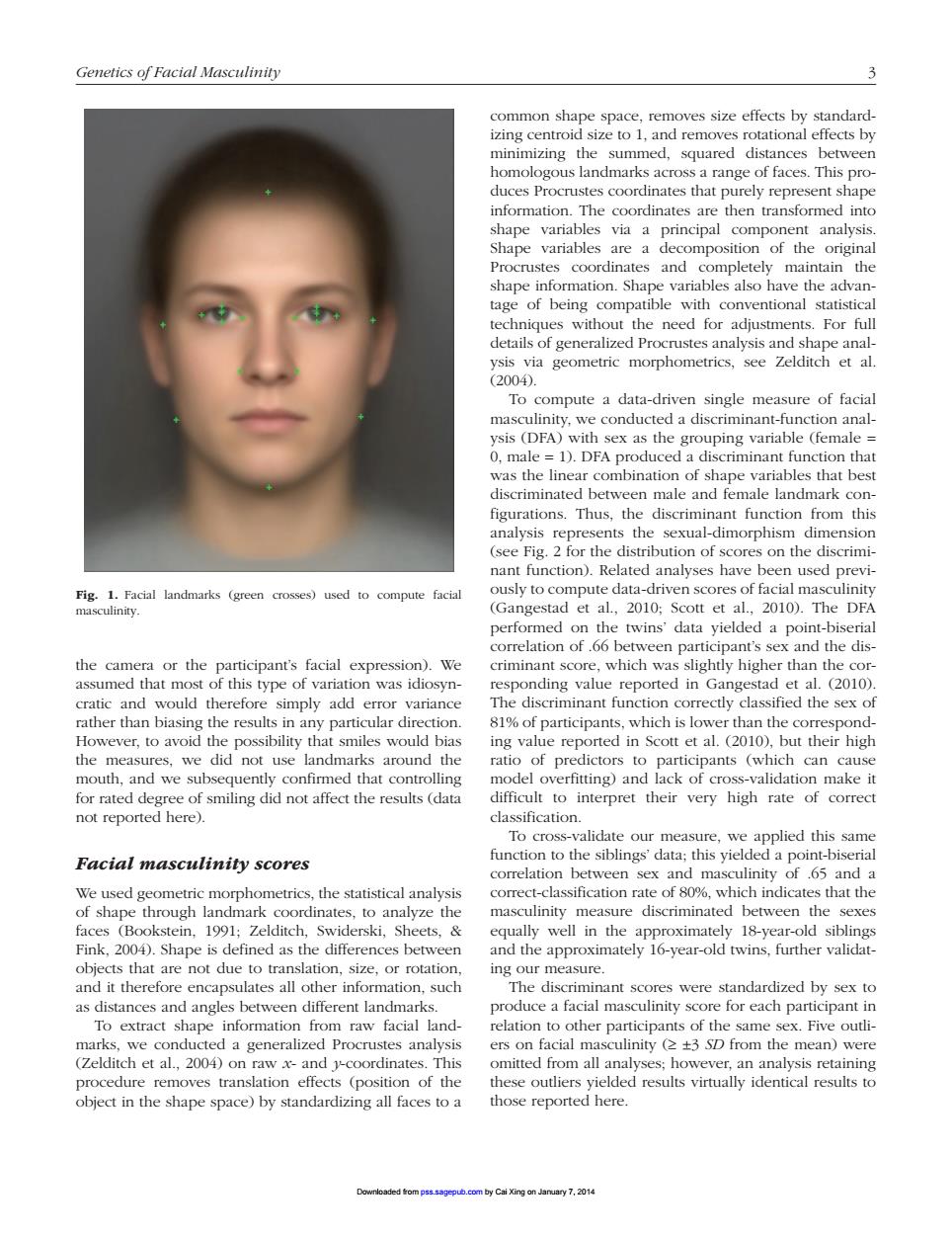正在加载图片...

Genetics of Facial Masculinity 3 common shape space,removes size effects by standard- izing centroid size to 1,and removes rotational effects by minimizing the summed,squared distances between ates that pure information.The coordinates are then tansformed int shape variables via a principal component analysis Shape variable are a decomposition of the ongir have tage of being compatible with conventional statistica techniques without the need for adjustments.For full ysisviarrustes analysis andldncha 1 et a To compute a data-driven single measure of facial masculinity,we conducted a discriminant-function anal ysis (DFA)with sex as the grouping varable (femal 1).DFA unction tha discriminated between male and female landmark con figurations.Thus,the discriminant function from this dimorphisn scores ously to co pute data-driven scores of facial masculinit (Gangestad et al 2010:Scott et al.2010).The DEA sex the c or the We ween pa assumed that mos reported in Gang tad et al (2010) cratic and would therefore simply add error variance The discriminant function correctly classified the sex of cdPoshay 81%of participants,which is lower s wou d th ue rep in scott e 10 -alidation makeit for rated degree of smiling did not affect the results (data difficult to interpret their very high rate of correct not reported here). classification 1o cro a te our Facial masculinity scores fun We used geometric morphometrics,the statistical analysis correct-classification rate of 80%,which indicates that the of shape through land ark coordinates,to analyze the masculinity iderski. eets and it therefore encapsulates all other information such The discriminant scores were standardized by sex to as distances and angles between different landmark: produce a facial masculinity score for each participant in extract s shape information from raw facial nd elation to other participants of the same sex.Five outl a ge ed fro procedure removes translation effects (position of the these outliers vielded results virtually identical results to object in the shape space)by standardizing all faces to a those reported here. 20Genetics of Facial Masculinity 3 the camera or the participant’s facial expression). We assumed that most of this type of variation was idiosyncratic and would therefore simply add error variance rather than biasing the results in any particular direction. However, to avoid the possibility that smiles would bias the measures, we did not use landmarks around the mouth, and we subsequently confirmed that controlling for rated degree of smiling did not affect the results (data not reported here). Facial masculinity scores We used geometric morphometrics, the statistical analysis of shape through landmark coordinates, to analyze the faces (Bookstein, 1991; Zelditch, Swiderski, Sheets, & Fink, 2004). Shape is defined as the differences between objects that are not due to translation, size, or rotation, and it therefore encapsulates all other information, such as distances and angles between different landmarks. To extract shape information from raw facial landmarks, we conducted a generalized Procrustes analysis (Zelditch et al., 2004) on raw x- and y-coordinates. This procedure removes translation effects (position of the object in the shape space) by standardizing all faces to a common shape space, removes size effects by standardizing centroid size to 1, and removes rotational effects by minimizing the summed, squared distances between homologous landmarks across a range of faces. This produces Procrustes coordinates that purely represent shape information. The coordinates are then transformed into shape variables via a principal component analysis. Shape variables are a decomposition of the original Procrustes coordinates and completely maintain the shape information. Shape variables also have the advantage of being compatible with conventional statistical techniques without the need for adjustments. For full details of generalized Procrustes analysis and shape analysis via geometric morphometrics, see Zelditch et al. (2004). To compute a data-driven single measure of facial masculinity, we conducted a discriminant-function analysis (DFA) with sex as the grouping variable (female = 0, male = 1). DFA produced a discriminant function that was the linear combination of shape variables that best discriminated between male and female landmark configurations. Thus, the discriminant function from this analysis represents the sexual-dimorphism dimension (see Fig. 2 for the distribution of scores on the discriminant function). Related analyses have been used previously to compute data-driven scores of facial masculinity (Gangestad et al., 2010; Scott et al., 2010). The DFA performed on the twins’ data yielded a point-biserial correlation of .66 between participant’s sex and the discriminant score, which was slightly higher than the corresponding value reported in Gangestad et al. (2010). The discriminant function correctly classified the sex of 81% of participants, which is lower than the corresponding value reported in Scott et al. (2010), but their high ratio of predictors to participants (which can cause model overfitting) and lack of cross-validation make it difficult to interpret their very high rate of correct classification. To cross-validate our measure, we applied this same function to the siblings’ data; this yielded a point-biserial correlation between sex and masculinity of .65 and a correct-classification rate of 80%, which indicates that the masculinity measure discriminated between the sexes equally well in the approximately 18-year-old siblings and the approximately 16-year-old twins, further validating our measure. The discriminant scores were standardized by sex to produce a facial masculinity score for each participant in relation to other participants of the same sex. Five outliers on facial masculinity (≥ ±3 SD from the mean) were omitted from all analyses; however, an analysis retaining these outliers yielded results virtually identical results to those reported here. Fig. 1. Facial landmarks (green crosses) used to compute facial masculinity. Downloaded from pss.sagepub.com by Cai Xing on January 7, 2014